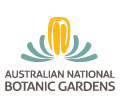 |
In Flower This WeekA weekly news-sheet prepared by a Gardens volunteerNumbers in brackets [ ] refer to garden bed 'Sections'. Plants in flower are in bold type. |
 |
In Flower This WeekA weekly news-sheet prepared by a Gardens volunteerNumbers in brackets [ ] refer to garden bed 'Sections'. Plants in flower are in bold type. |
30 November 2001
The Main Path starts at the corner just past the Café. Leptospermum minutifolium [Section 10] is an older shrub but its small leaves and tiny white flowers are a delight; opposite is Kunzea ambigua [Section 12], a prostrate plant with lots of fluffy white perfumed flowers. Close to the path is Chamelaucium uncinatum [Section 12], with bright magenta flowers. Along the path are a variety of Callistemons, most in flower.
Leptospermum polygalifolium subsp. tropicum [Section 10] is an old specimen but its profuse, tiny, white flowers show it off very well. A little way along, the Aboriginal Plant Walk goes off to the left. Melaleuca wilsonii [Section 9] has lots of crowded, rounded, pinkish-purple flowers. On to Kunzea x capitata [Section 9], with lots of fluffy pink pom-pom flowers. Keep going until you cross a road and on your left is a seat, pleasantly framed by plants of Grevillea nudiflora [Section 24] with their dainty foliage and bright red flowers. Isopogon divergens [Section 26] is another small plant with conspicuous mauve flowers. In the next section are several flowering boronias and one that particularly catches the eye with its very bright showy red flowers is Boronia ‘Carousel’ [Section 112].
Cross to the Sydney Region Gully. A group planting of Scaevola ramosissima var. ramosissima [Section 191h], a ground cover plant with pale purple flowers. On the right is Tetratheca thymifolia [Section 191s], with white flowers and covering a large area for such a small plant. On the left is another group planting, this time of the much taller Jacksonia scoparia [Section 191h], a blaze of striking gold-coloured pea flowers. Further on, on the left, are lots of the large, white flowering Actinotus helianthi ‘Federation Star’ [Section 191p], together with other varieties of the Flannel Flower. The strappy plant of Patersonia sericea [Section 191g] has delightful, mauve-purple flowers and then a group of the low growing, bright yellow Hibbertia pedunculata [Section 191j]. There are lots of flowering plants to see and enjoy in this section.
The beds around the edge of the Eucalypt Lawn are always worth dawdling around. Keep following the Main Path, past the wattles which have finished flowering, and cross over the road. On the corner is Hakea trineura [Section 20], though past its best, its red flowers are still dotted with the yellow-gold. At the edge of the Rock Garden, on the right, is Melaleuca squarrosa [Section 15], a large bush covered with creamy cylindrical flowers. Follow the path to the waterfall in the Rock Garden to admire the profusion of colours. Then, almost opposite the caged Wollemi Pine, is Olearia stellulata [Section 16], a truly lovely daisy bush in full flower. Return to the car park by going through the Rainforest Gully on the boardwalk, or turn left at the road just before the Rainforest Gully and head downhill to the Café.
Enjoy your visit! Naomi Bell
| Return to: | Australian National Botanic Gardens | Previous
'In Flower' Weeks |